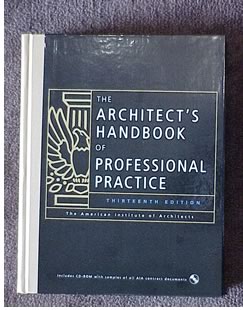
Adapted from the Robin Ellerthorpe, FAIA, introduction to the 13th edition of The Architect's Handbook of Professional Practice.
 In
today's business world, architects encounter more demanding clients and
face competitors from both within and outside the architecture profession.
To help architects deal with these challenges, the 13th edition of the
Architect's Handbook of Professional
Practice departs from the viewpoint of earlier editions. It does
so by redefining its audience, its content, and—at times—the
fundamental concept of the Handbook
itself.
In
today's business world, architects encounter more demanding clients and
face competitors from both within and outside the architecture profession.
To help architects deal with these challenges, the 13th edition of the
Architect's Handbook of Professional
Practice departs from the viewpoint of earlier editions. It does
so by redefining its audience, its content, and—at times—the
fundamental concept of the Handbook
itself.
This edition also introduces ideas and concepts that can help architects become proactive leaders in creating a better-built environment, even though some of these ideas have not yet become industry standards.
The Institute began its current focus on clients,
which underlies the 13th edition, at a watershed event in 1995 called
the AIA Summit on Expanding Architectural Services. To be sure, the AIA
has a history of assembling client focus groups to address issues such
as contracts, advertising, and liability. The summit event, however, permitted
a broad level of input from clients such as Quorum Healthcare and the
Bank of America. Some of the client participants were emotional in their
appreciation for being listened to; others were indignant and insisted
that they be understood. They spoke about architects in terms of their
needing to:
• Go beyond projects
• Offer a broad range of services
• Develop long-term architect-client relationships
• Consider the facility life cycle
• Emphasize the role of facilitator and integrator.
These client voices created the platform for the Institute's Practice & Prosperity program, which eventually evolved into the Redefinition of the Profession initiative, which, in turn, has been greatly informed and focused by the AIM (Aligning the Institute for the Millennium) initiative.
Informed practice
tools
The Architect's Handbook has been
closely linked to the AIA contract documents from its first publication
in 1917. This edition may be even more closely linked because many of
the same forces—through interaction among the Documents Committee,
PIAs, and Institute realignment programs—that have shaped and are
shaping new editions of the AIA contract documents also shaped this Handbook
edition. With Document B141-1997, Standard Form of Agreement Between Owner
and Architect, for instance, the basic services embodying building design
remain. However, a new modular format enables discrete service descriptions
to supplement or wholly supplant the basic services. In this approach,
the client can better understand the scope and importance of any array
of services along with the compensation for providing them. The strategy
underlying this client-service approach is thoroughly described in the
new Handbook.
Market readiness
and agility
Market readiness is another vital aspect of the new Handbook edition.
A combination of economic expansion and more sophisticated clients in
most markets has resulted in demand for services that ranged beyond the
traditional design-bid-build approach. Thus began a fundamental shift
in architecture, one that struck at the strategy of firms as it played
out against the building blocks of core competencies, service processes,
and the skill sets housed within them. The shift was driven by recognition
that building life cycle services required more than traditional architectural,
engineering, and interior design skills. Now that we are seeing a slowdown
in the economy overall, we can anticipate new facility-related needs as
clients look to get every possible value-adding edge up on their competitors.
Coupling additional skills with new processes to meet client service requirements
as they evolve has become the recognized key for future growth and opportunities.
Taking its cue from visionary business strategists, the Handbook is intended to move the profession from an either/or mentality—where architects provide a narrow set of services—to a position in which core competencies and extended capabilities are combined to deliver a comprehensive array of facility services. In this transformation, architects have the opportunity to provide greater value to their clients and reestablish themselves as leaders and valued partners in the design and construction arena.
Copyright 2001 The American Institute of Architects. All rights reserved.
![]()
|
|
|